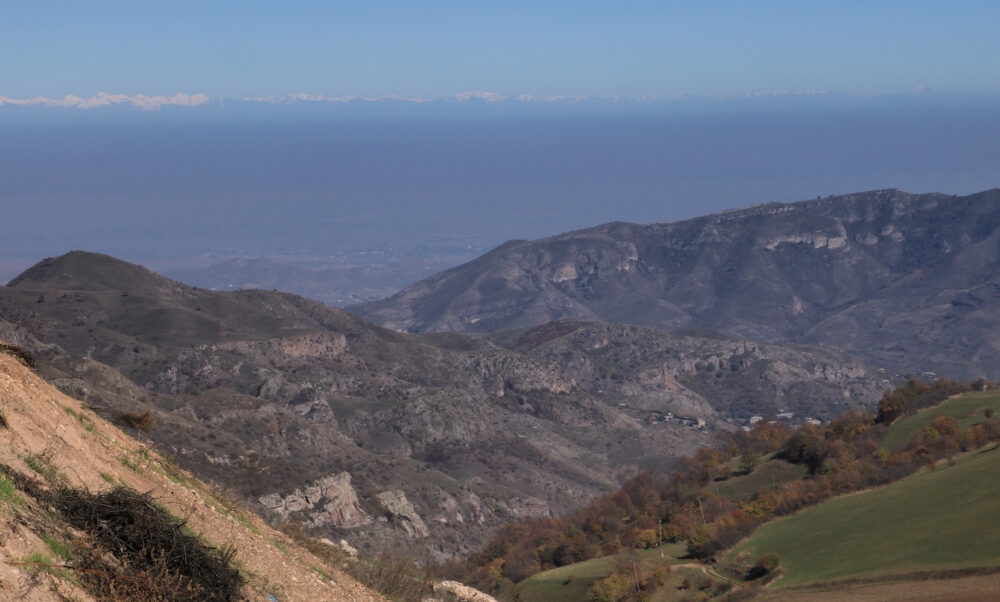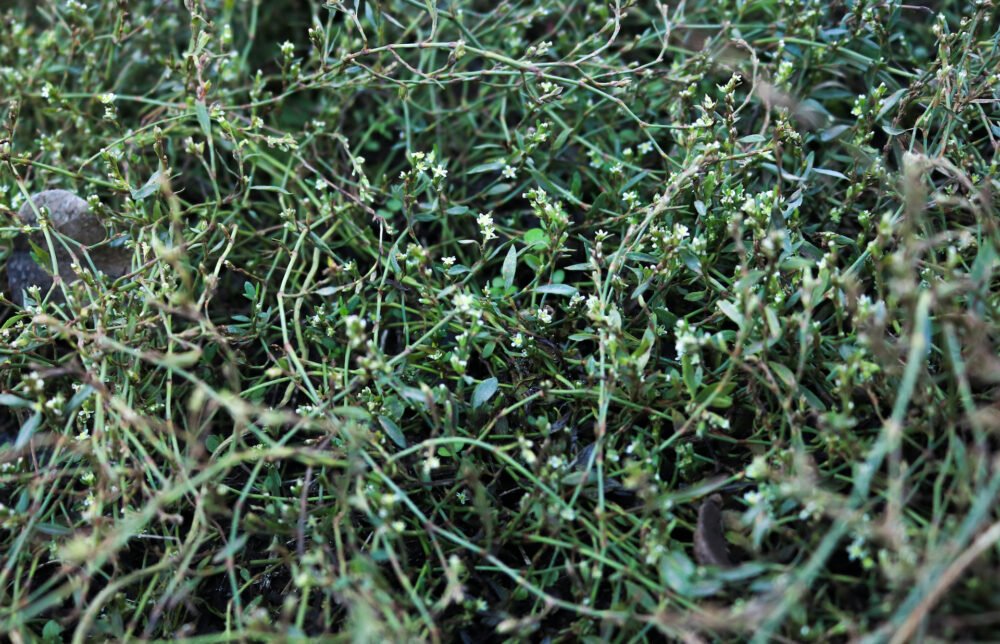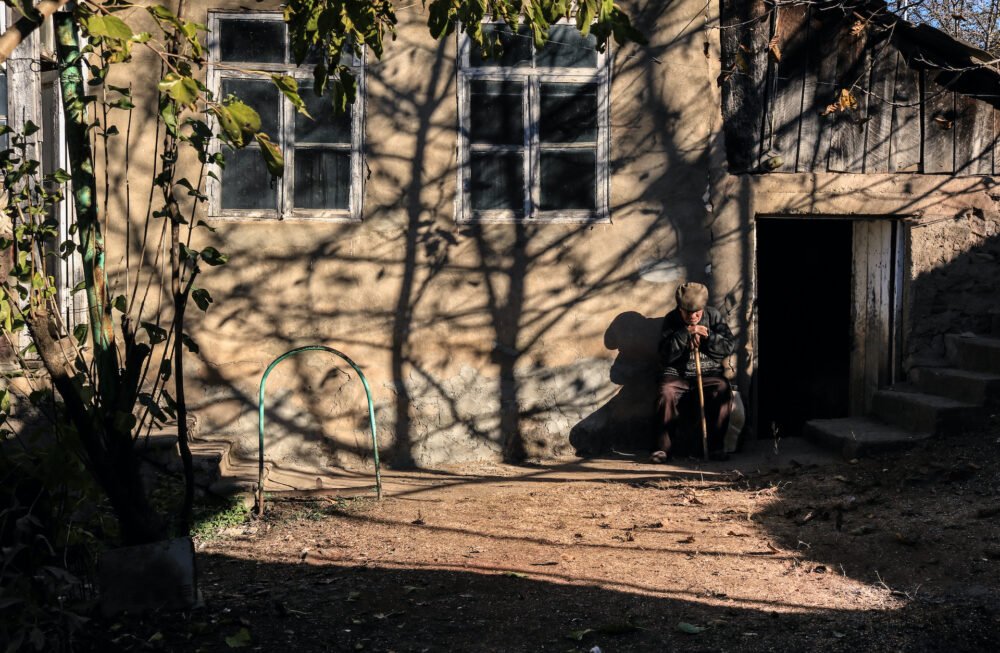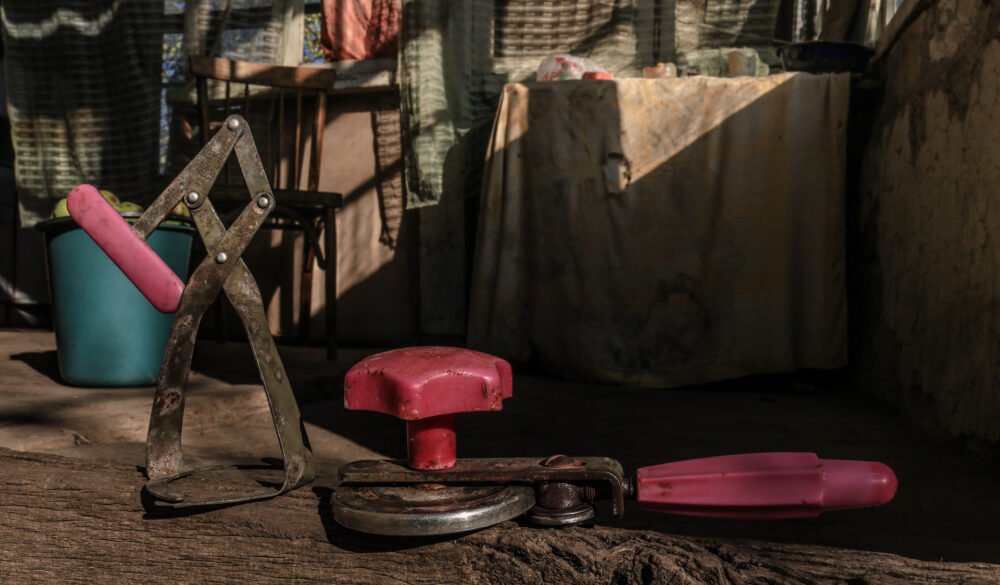
The Russian Empire railway system in the South Caucasus was established between 1872 and 1913 1. The rails passed through territories in the provinces of Tiflis, Baku, Erivan, Kutaisi, Kars, and the Yelizavetpol Oblast, contributing to the rapid development of the Transcaucasian oil extraction and refining sectors and the manganese ore industry 2. The railways significantly influenced the development of agricultural production in Transcaucasia by expanding the export of products to domestic and foreign markets. Additionally, the Transcaucasian railways strengthened Russia’s military and political position on the borders with Turkey and Persia/Iran. They established economic interdependence between the various parts of the South Caucasus and their subordination to the center, as they were part of a wider infrastructure network that connected the periphery with the center.
The Tiflis-Baku line of the Russian/Soviet railway system, from which the Akstafa-Ijevan railway branch was planned in the 1920s-30s to directly connect the northwestern part of Azerbaijan with Armenia and to lay Armenia’s second railway line. The first five-year plan of national-economic construction of the USSR stated: “Pioneer significance for the mountainous regions around lake Sevan, has the branch Akstafa-Ijevan (length 50 km, cost 3.550 thousand rubles), which in the future, after the current five-year plan, is expected to extend to Erivan 3″. However, due to the complexity of the section and the Second World War, it took several decades to complete the project. The Ijevan-Akstafa railway was opened in 1971. The main purpose of this line was to transport industrial goods 4 and make Armenia’s mountain villages more accessible for those in the regional centers.
There are only four border interconnection stations on the Armenian railway: Ayrum-Sadakhlo (on the border with Georgia), Akhuryan-Dogukapi (Turkey), Yeraskh-Velidagh (Azerbaijan/Nakhichevan) and Ijevan-Barkhudarli (Azerbaijan). Of these, only Ayrum-Sadakhlo is still operating today. Due to the Armenian-Azerbaijani conflict in 1988-1994 and the subsequent blockade of Armenia, train traffic between Ijevan and Akstafa stations was halted. In 1994, a section of the Dilijan-Ijevan line collapsed, but was never restored due to its low activity. Presently, the station is a terminus and there is no further railway traffic towards Azerbaijan.
The Tovuz railway station was not located on this branch line, yet as it was 20 km from the Armenian-Azerbaijani border and 22 km from the Akstafa railway junction, it was a transit point and served all Armenian and Azerbaijani settlements nearby. In these settlements the older generation still remembers the times when the border did not exist. A time marked by free communication with Tovuz and other parts of Azerbaijan, people from both sides traveling, communicating, engaging in trade and becoming dosts (Az. friends) 5 or qonaqs (Az. guests) 6․ This was because prior to the escalation of the Armenian-Azerbaijani conflict in the late 1980s, the main road connecting the town of Berd and surrounding villages to the district center of Ijevan passed through the territory of Azerbaijan (the towns of Tovuz, Akstafa, and Gazakh). The road formed a circle, and so returned back to the Armenian SSR. A mountain road directly connecting Berd with Ijevan had not yet been constructed before the first Karabakh war began. The alternative road from Berd to Chambarak (formerly Krasnoselsk) through the mountains was not properly built and was often closed under a thick layer of snow during the winter months. Therefore, Berd and some of the Armenian border villages were more closely linked, both economically and on a daily basis, to the Tovuz railway station. During the Soviet period the district was economically supplied from Berd, where all necessary goods were delivered by railway and bypass roads from Tiflis, Yerevan, and Ijevan. Thus, one can observe how railways, roads, and borders (various infrastructural elements) have linked and divided Armenian and Azerbaijani settlements and populations on a small piece of land at different periods in time. Hrant (all names have been changed), a resident of the village of Nerqin Karmiragbyur, recounts,
“We used to carry cigarettes and manufactured raw materials to factories both in Yerevan and the former Soviet Union. We used to load and ship goods from Tovuz station in Azerbaijan to about 30-40 cities. The borders of the Soviet republics were conditional. There were no border guards, the roads were not interrupted by customs posts. People could cross from Armenia to Azerbaijan or from Azerbaijan to Armenia several times a day without presenting any documents to anyone. And perhaps this is why Aygepar [the village and surroundings] lived more than 200 km away from Yerevan, without a peripheral complex” 7.
Anahit, from Verin Karmiragbyur, says that she used to go to Tovuz by bus or on foot with her husband to buy “spoons, fabric, leather for sewing shoes, we used to buy everything there, we used to buy fish in bundles. We used to go to their villages for caterpillar-plant and mallow, their villages were very close to us 8”. Another woman from the same village, Alla, told us, “From our bus stop we used to go to Berd and from there to the Tovuz station. The bus went three times a day. On the way in Alibeyli village, we used to buy wool to make blankets and mattresses for winter. We were buying better goods from under the counters at Tovuz station. German, Yugoslav shoes and clothes were impossible to find in Yerevan, so we bought them in Tovuz from Azerbaijani acquaintances. We used to come and ask them to show us the good stuff, and they would show us what was not on display on the counters 9”. Various everyday practices (trade, agriculture, cattle breeding, holidays and mourning days, cultural events, educational exchanges, etc.) linked Armenian and Azerbaijani villages by numerous threads. Even particular practices, such as local traditional healing, united the local multi-ethnic population. Alvard, from the village of Verin Karmiraghbyur 10 , recalls,
“When our children fell ill with diarrhea, cough or a stuffy nose, we used to say that they had straw stuck in their noses. We would take them to Tovuz station, to the folk healer to blow out the straw and cure them. For example, one day I took my son to her. When we arrived, we asked the locals where the house of the khyrdakhala (Az. little auntie) or chopchi (Az. bone) 11 was. When we arrived, she cured my son by blowing a bundle of straw and a piece of Armenian newspaper out of his nose”.
Residents in the two nations have lived side by side for several hundred years, as members of the same nation would have done, experiencing shared daily routines, problems, friendships and feuds.
Everyday communication between Armenians and Azerbaijanis was mainly based on trade and economic relations, the security of which was guaranteed through the institute of “dost”, which survived in a number of villages even after the First Karabakh War. Elia’s house is close to the Armenian-Azerbaijani border. Simply, on the border between the villages of Aygepar and Alibeyli. Despite the numerous marks of artillery shells, the house reveals that its owners were once successful workers. “My husband and his father owned blacksmith shops at that time. In the village opposite, called Alibeyli, all the gates and water tanks were made by my husband and his father. Even in Tovuz everyone knew them very well,” tells Elia, proudly pointing out that the connections were not only defined through labor, but also kinship. Looking out of the ground floor window of Elia’s house, one can see ruins stretching all the way from the house to the neighboring Azerbaijani village, “Do you see these ruined walls? This was our canning factory. Now only the walls are left,” says Elia. She points out a building with red arches, “It was a bus stop. People used to take a bus there and go to Tovuz station to trade“. She recalls a relative of hers who lived in Tovuz, “His name was Mejit. They were very good people. We were very good dosts 12“.
Haik from the Verin Karmiraghbyur village recounts that after the First Karabakh War, “when the situation was quite tense in 1994-1995, there were occasions when the dosts still used to come, secretly crossing the border and attending the funerals or weddings of their Armenian friends. Usually the whole village knew about it. Of course, they could not walk freely around the village, but stayed safely in the houses of their dosts 13”. Alla says of the phenomenon, “A dost is a friend, but a committed friend, in a different way, for example, here an Armenian may betray his friend, but a dost does not betray his dost. Mostly dosts were closer than an Armenian to an Armenian 14”. These dynamics of Armenian-Azerbaijani interpersonal relations served as a significant means of resolving and managing inter-ethnic conflicts. Despite its significance, our knowledge of the phenomenon is quite limited, as the latter has not been sufficiently studied in its active period. In the North Caucasus, however, its manifestations, atalyk (Az. fatherhood, fosterage) and qonaq 15, have been studied quite extensively, a detailed description of these are presented in the Armenian epic poem “The Daredevils of Sassoun”.
From these interviews, it is clear that in this border region the custom of fosterage was also common between Armenian and Azerbaijani dost families. The motivation was not material, but rather to widen the circle of non-blood relatives and reduce the possibility of conflict between families, clans, and communities. The dosts-qonaqs were bound together by mutual support and participation in each other’s most important affairs. “Dost” friendship was hereditary and characteristic of both women and men, mostly within the older generation. Their families continued to maintain qonaq ties, becoming kinsmen, helping each other in the most significant affairs, paying each other visits, going to weddings and funerals together.
Thus to this day the local memory of the site retains many elements of Azerbaijani presence: “There was an old woman who was very close to us and came to our village every day by bus, we called her Turk Tamar. She was very familiar with everyone, and knew everyone in the village by name, as she had been coming to us for many years. She used to sell sunflower seeds at the corner of the bus stop. The villagers still say that this is the place of Turk Tamar”, Alla recalls with a smile and warmth in her eyes.
Conclusion:
It is striking that after the collapse of the USSR, those lively settlements that were situated on important roads and had an everyday life closely intertwined with neighboring villages, are now virtually isolated on the periphery of the country. This is part of the strategic mapping of the major infrastructures of the metropolis (in this case, the central power of the USSR). Within the policy of shared infrastructures, when a metropolis collapses, its periphery loses vitality. After the collapse of the Soviet Union, the newly formed nation-states were forced to create new borders and change the principle of how infrastructures operate, directing them to their own capitals․
This article illustrates how social relations are closely linked to infrastructure and how conflicts and borders destroy both infrastructure and thus people-to-people relations. This highlights the artificiality of nationalist narratives and how they function to create a double periphery for people: the loss of connections through roads, railways and infrastructure, and with neighbors with whom they have lived side by side for centuries. Moreover, in terms of center-periphery relations, the central – and mostly militarist-patriotic – narratives are fundamentally disconnected from the grassroots, lacking any representation of the pragmatic and experience-driven practices of peaceful cohabitation between different ethnic groups in these border areas.
Read the memories of Azerbaijani Memories About Tovuz Railway Station : https://caucasusedition.net/tovuz-memories-of-akstafa-dilijan-railway/
1 The main railway lines were: Poti – Tiflis (opened in 1872), Baku – Tiflis – Batum (1883), Mikhailovo – Borjomi (1894), Tiflis – Kars (1899), Aleksandropol – Erivan (1902), Ulukhanlu – Julfa (1908), Kars – Sarighamish (1913). (Argutinsky-Dolgorukov A., The History of Transcaucasian Railway construction and exploitation for 25 years of its existence. 1871-1896, Tiflis, 1896; Sagratyan A., History of Transcaucasian railways. 1856-1921, Yerevan, 1970. URL: https://rzda.ru/info/articles/zakavkazskie-zheleznye-dorogi/).
2 Shanidze N., Emergence and Development of Transcaucasian Railways and Their Impact on the Economy of the Region, Tbilisi, 1968.
3 Five-Year Plan of National Economic Construction of the USSR (First Five-Year Plan 1928-1933); Volume 3. District Section of the Plan; Transcaucasian SFSR; Five-Year Plan of National Economy of the Transcaucasian SFSR; URL: http://istmat.info/node/45079
4 Minasyan A, Ijevan railway station, URL: https://urbanista.am/ijevan-railway?fbclid=IwAR26IGAcyRY-HMZWiLlvzWtoSRw63rzx54-NaoInVaC84H3XL3KjQb_8MYM։
5 Dabaghyan A., Gabrielyan M., Economy, Trade and Ethnicity in Borderlands: An Ethnographical Survey in the Tavush Province of Armenia, Yerevan, 2008, p. 95-99.
6 Caucasian Digest / Ed. by V.V. Degoev, Moscow: Aspect Press, 2017. p. 58, URL: https://mgimo.ru/upload/iblock/c9c/Kavkaz-X.pdf.
7 Paskevichyan T․, The Forgotten Center of the World, Publication date: 15․05.2006, URL: https://hetq.am/hy/article/10176
8 Anahit, a woman of about 90 from the village of Verin Karmiragbyur, interview, 23.10.2021
9 Alla, 59-year-old woman from the village of Verin Karmiragbyur, interview, 23.10.2021
10 Alvard, 79-year-old woman from the village of Verin Karmiragbyur, interview, 23.10.2021
11 Healing practice in traditional Azerbaijani medicine that involved “blowing out” fruit kernels, seeds or meat bones stuck in the throat and nose of children or adults. (Lisitsian S., Armenians of Nagorno-Karabakh. Ethnographic Review. – Yerevan: Academy of Sciences of the Armenian SSR, 1992, pp. 159, 249)
12 Paskevichyan T․, The border between the past and the future, Publication date: 22.05.2006, URL: https://hetq.am/hy/article/10187.
13 Haik, 63-year-old man from the village of Verin Karmiragbyur, interview, 23.10.2021
14 Alla, 59-year-old woman from the village of Verin Karmiragbyur, interview, 23.10.2021
15 Kosven M., Atalyk / Soviet Ethnography, 1935.; Abaykhanova P., Peculiarities of the institution of artificial kinship among the people of the North Caucasus, North Caucasus Legal Bulletin, 2014, N1, pp. 52-58




